Genomic transcriptional response to loss of chromosomal supercoiling in Escherichia coli
- PMID: 15535863
- PMCID: PMC545778
- DOI: 10.1186/gb-2004-5-11-r87
Genomic transcriptional response to loss of chromosomal supercoiling in Escherichia coli
Abstract
Background: The chromosome of Escherichia coli is maintained in a negatively supercoiled state, and supercoiling levels are affected by growth phase and a variety of environmental stimuli. In turn, supercoiling influences local DNA structure and can affect gene expression. We used microarrays representing nearly the entire genome of Escherichia coli MG1655 to examine the dynamics of chromosome structure.
Results: We measured the transcriptional response to a loss of supercoiling caused either by genetic impairment of a topoisomerase or addition of specific topoisomerase inhibitors during log-phase growth and identified genes whose changes are statistically significant. Transcription of 7% of the genome (306 genes) was rapidly and reproducibly affected by changes in the level of supercoiling; the expression of 106 genes increased upon chromosome relaxation and the expression of 200 decreased. These changes are most likely to be direct effects, as the kinetics of their induction or repression closely follow the kinetics of DNA relaxation in the cells. Unexpectedly, the genes induced by relaxation have a significantly enriched AT content in both upstream and coding regions.
Conclusions: The 306 supercoiling-sensitive genes are functionally diverse and widely dispersed throughout the chromosome. We propose that supercoiling acts as a second messenger that transmits information about the environment to many regulatory networks in the cell.
Figures
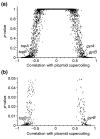
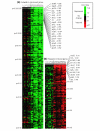
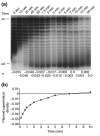
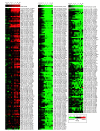
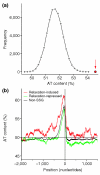

References
-
- Funnell BE, Baker TA, Kornberg A. In vitro assembly of a prepriming complex at the origin of the Escherichia coli chromosome. J Biol Chem. 1987;262:10327–10334. - PubMed
-
- Wang JC, Lynch AS. Effects of DNA supercoiling on gene expression. In: Lin ECC, Lynch AS Austin, editor. Regulation of Gene Expression in Escherichia coli. TX: R.G. Landes Company; 1996. pp. 127–147.
-
- Rui S, Tse-Dinh YC. Topoisomerase function during bacterial responses to environmental challenge. Front Biosci. 2003;8:d256–d263. - PubMed
-
- Pruss GJ, Manes SH, Drlica K. Escherichia coli DNA topoisomerase I mutants: increased supercoiling is corrected by mutations near gyrase genes. Cell. 1982;31:35–42. - PubMed
Publication types
MeSH terms
Substances
LinkOut - more resources
Full Text Sources
Other Literature Sources
Molecular Biology Databases

